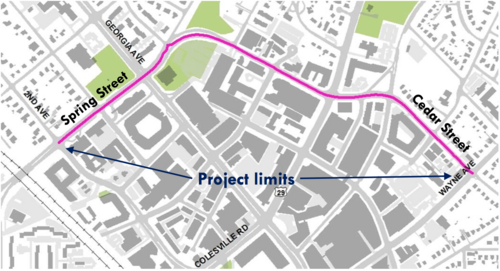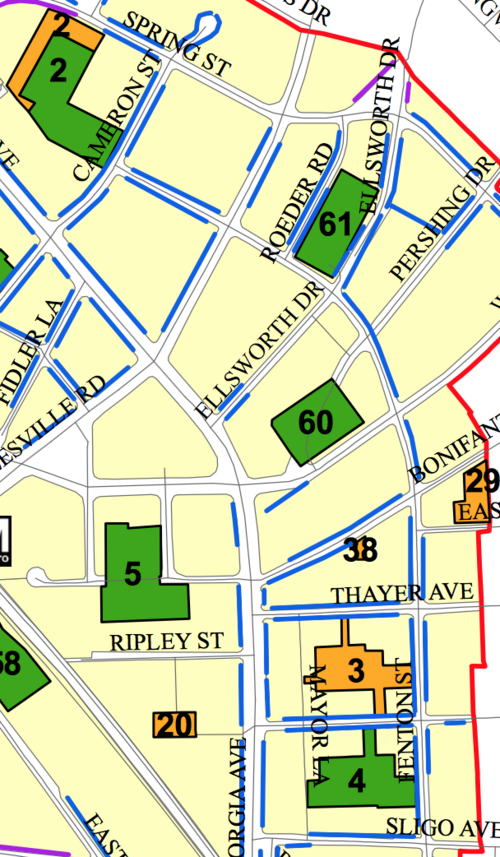Some Silver Spring residents are against bike lanes that haven’t even been proposed yet
Big plans for bike routes in Montgomery County are underway, and Silver Spring is a focal point. When one group of neighbors learned that the county is studying the possibility of a new bike lane near their homes— a far cry from considering any actual plans in detail— they immediately voiced vehement opposition that overstates the downsides and understates the benefits of bike lanes.

Sharrows at the intersection of Silver Spring Avenue and Fenton Street. Bike lanes on Fenton could make the area even more bike-friendly. Photo by Dan Reed.
Silver Spring has been designated as a Bike and Pedestrian Priority Area, meaning it’s getting extra funding for bike infrastructure improvements. So far this has resulted in plans for separated bike lanes on Spring and Cedar Streets, with construction set to begin this year.
In addition to these and other planned lanes, Montgomery’s department of transportation has examined important downtown Silver Spring corridors. For example, there has been mention of studying possible bike lanes along Fenton Street, which could conceivably be implemented in conjunction with a massive PEPCO dig project on Fenton Street that will take place in the next several years.
But even with the study not underway yet, some nearby residents expressed loud opposition to any possible bike lanes. They created a petition with the following claims (all the capital letters are part of the original):
- Not necessary because there is CURRENTLY A DESIGNATED COMMUNITY BIKE ROUTE — “Grove Street Bike Route” — THAT PARALLELS FENTON STREET along Cedar Street, Bonifant Street, Grove Street and Woodbury Drive.
- A Fenton bike lane REMOVES PARKING and DELIVERY TRUCK LOADING AREAS from the Fenton Village businesses.
- A Fenton bike lane INCREASES MORE UNWANTED PARKING ON NEIGHBORHOOD ROADWAYS (Bonifant Street, Easley Street, Thayer Ave, Silver Spring Ave and Grove Street) because Fenton Village customers will seek parking on the neighborhood roadways adjacent to Fenton Street instead of in parking structures.
- A Fenton bike lane FORCES MORE UNWANTED LARGE DELIVERY TRUCKS, INCLUDING 18 WHEELERS, ON NEIGHBORHOOD ROADWAYS adjacent to Fenton Street for loading / unloading to businesses in Fenton Village.
- A Fenton bike lane INCREASES TRAFFIC ON THE NEIGHBORHOOD ROADWAYS, particularly on narrow Grove Street, a neighborhood roadway outside the Silver Spring CBD.
This level of vehement opposition is out of proportion to any impacts of possible bike lanes. Many of the concerns are also misplaced. To address all of them:
- The current bike route goes through minor neighborhood streets and consists almost entirely of sharrows since it would never have enough bike traffic to warrant protected lanes. Lanes on Fenton would serve as a much better connector for the Downtown Silver Spring bike network and would also make it easier to get to shops and residences along Fenton.
- There are four public parking decks and three public lots within a block of this route, in addition to adjacent private lots for shoppers. We should definitely work to develop strategies to better direct people to parking if that is a concern, but there is no shortage of parking. Moreover, MCDOT plans to carry out a parking study to identify any issues with parking in and around the Fenton Street corridor, with any findings informing the ultimate proposal.
- Parking in nearby residential neighborhoods is easily addressed with neighborhood parking permits, which Montgomery County seems to enforce quite well. East Silver Spring already has such a system, and it seems to work smoothly.
- We should definitely have a discussion about how best to accommodate delivery trucks, but there’s no need for that to start with “NO BIKE LANES!!”
- Fenton is already quite congested at rush hours, and it’s not at all clear how bike lanes would divert more traffic. More importantly, MCDOT plans to carry out a traffic study before making any proposal. And finally, a wealth of previous research has shown that well-designed bike lanes don’t cause congestion.


